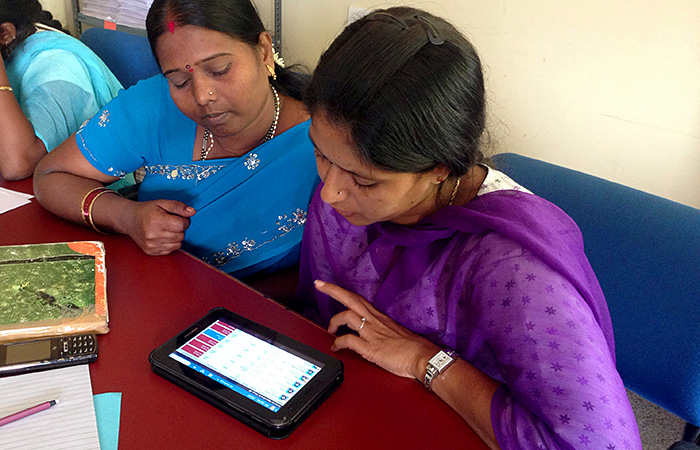Tips for tech training: how we’re introducing DRISTHI to India’s rural community health workers

To prepare for a larger scale up in northern Karnataka later this year, we have been working with DRISTHI Partners, the Foundation for Research in Health Systems (FRHS) and the World Health Organization (WHO), to refine our training curriculum and at the same time, collect feedback on UI improvements. On our recent trip to India, we completed a pilot training of the DRISTHI app that went extremely well. By the end of the day, our students, recent Auxiliary Nurse Midwife (ANM) grads, were able to fulfill basic ANM duties, like identifying children in need of specific immunizations and recording services. Here are a few tips about what worked for us in introducing new technology to health workers with varying levels of tech-knowledge:
1. A local, knowledgeable and engaging instructor is the most important element of training. This might seem obvious, but the point is, as much work as you put into planning, content and training materials, none of it matters if you don’t find the right person to do the training. In our case, Jagannath Purushotham, was very familiar with DRISTHI and the ANM program and was able to tie technical functions with ANM duties during instruction.
2. Local, knowledgeable assistants make learning faster. We had a compressed time schedule, so we used FRHS field investigators to partner with 1 or 2 ANMs to assist with instruction. At the beginning of the day, assistants addressed smaller learning obstacles, while later in the day they challenged ANMs with specific tasks using the app.
3. Focus training on benefits to motivate ANMs. Most training sessions focus on dumping as much information as possible onto an unknowing recipient. We took time to focus on how it would make it easier for them to track patients and would reduce the amount of time they would have to spend referencing their paper registers in order to calculate indicators by hand.
4. Keep your students engaged and active by interacting with them. Ask them questions. Get them to come up to the screen and interact with it like’s it’s a touchscreen. This will get them thinking about real applications to the technology rather than trying to memorize exactly what the instructor is saying. You can also use cheap tricks: we brought candy and super-sweet Masala Chai for pick-me-ups and played quick games for a boost of energy.
5. Provide ample time for open exploration. This is where the real learning happened, especially with the aid of our field investigators/teaching assistants. When the instructor (and designers) left the room, ANMs started making comments openly and exploring DRISTHI without fear of making mistakes. Another benefit was open exploration led naturally to role playing activities so ANMs could think of DRISTHI in their daily work. We used preplanned scenarios that correlated with the data on the app. In one case, Dhivya, a field investigator, played the role of a mom in Hosa Agrahara village who had her IUD inserted 30 days ago and was having complications. The ANM was able to find her case and check up on her with DRISTHI.
6. Focus on communicating large concepts. If necessary, create a reference manual to help keep details separate from the main points you are trying to make during training. The details will be far more valuable once ANMs are comfortable with the technology.
As we continue developing DRISTHI and the training curriculum, we are constantly working to improve our techniques and experiment with ways to communicate complex ideas. Look out for future blog posts where we’ll share more about what we’ve learned and info on how we’re scaling-up best practices.
ಶುಭ ದಿನವಾಗಲಿ!
DRISTHI is an effort we began over a year ago that uses mobile technology to improve the impact of community health workers. The DRISTHI app simplifies complex maternal and childhood healthcare (such as family planning, pre-and-post natal care, anemia preventation, immunization coverages among infants, etc.), allowing ANMs to maintain a high level of service to hundreds of patients. Using a digital data format also eliminates the tedious calculating of hundreds of health indicators for monthly reporting, giving ANMs more time for face-to-face interaction.


